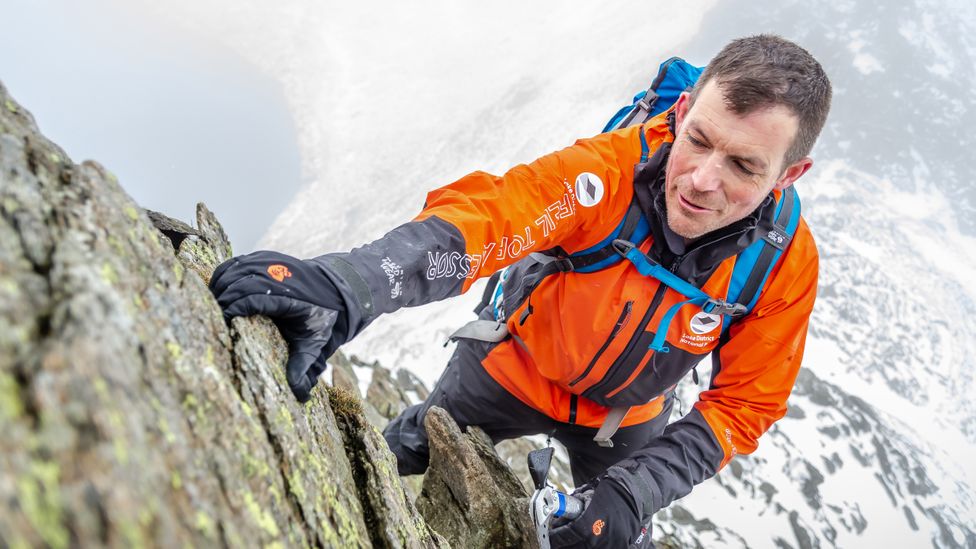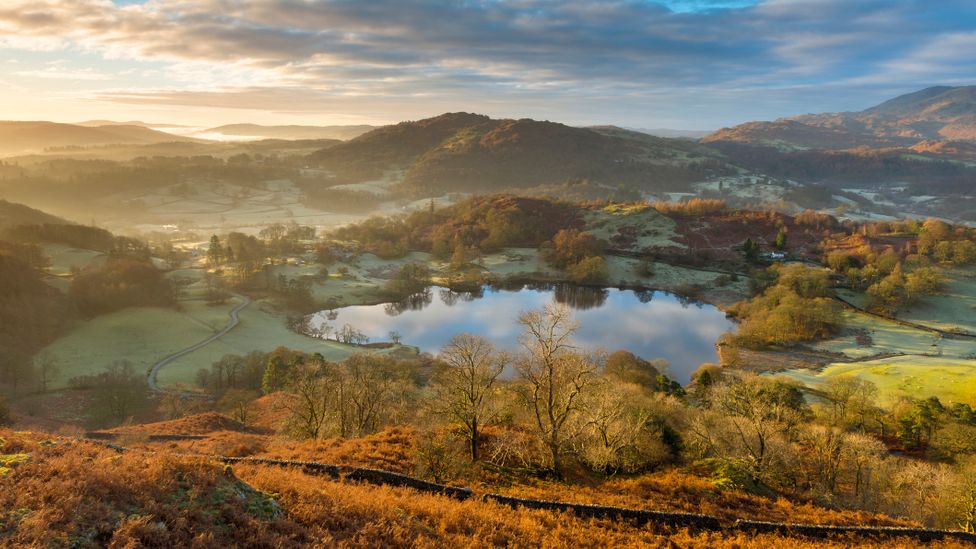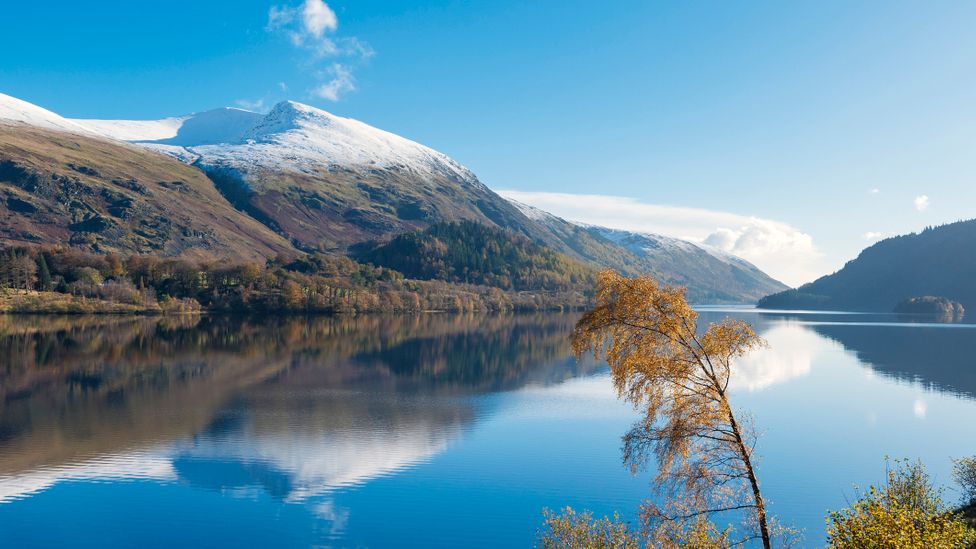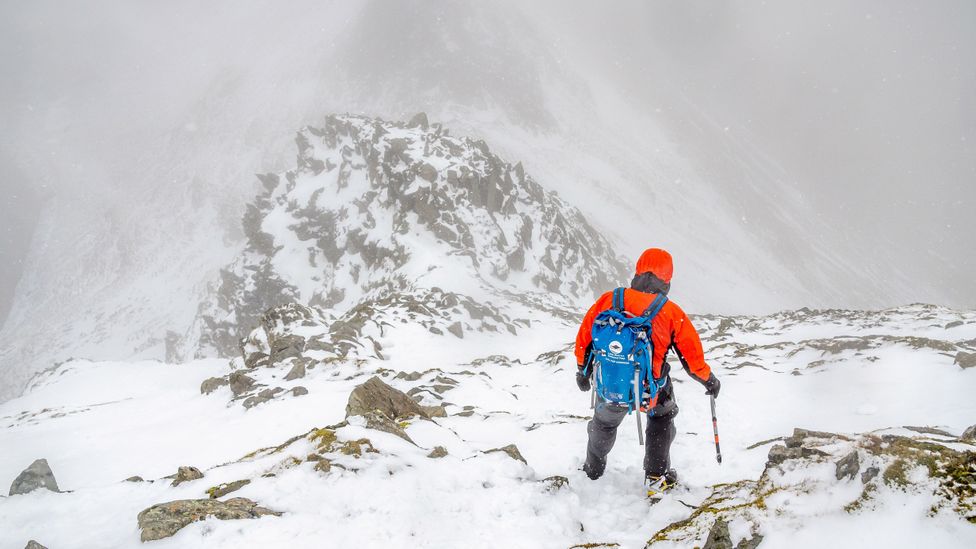It was late afternoon in the Lake District and Zac Poulton, a picture of cool with a tight crewcut and an Everest gleam in his eyes, was scrambling up jagged rocks with the muscular ease of a prize mountain goat. Between precise athletic moves and boldly finding footholds, he was telling me he is the owner of England's greatest collection of single gloves. Or at least, he thinks he is.
"I've got all sorts, shapes and sizes," he said, manoeuvring over a glass-slick slab of rock above the pale-yellow moorland. "Along with dealing with snow, ice, wind and the worst that nature can throw at me, dealing with lost property is one of the stranger challenges of my job."

Every day from December to April, a Fell Top Assessor must hike Helvellyn to report the weather conditions (Credit: Fell Top Assessors)
That occupation – as Fell Top Assessor in the wildly popular Lake District National Park – is one of the strangest in Britain. For the past four winters, Poulton has hiked up Helvellyn, England's third highest and most dangerous peak, more than 200 times to report the weather and write an atmospheric, colourful account that can be used, understood and acted upon by the public to summit safely.
You may also be interested in:
• Scotland's little-known Highlanders
• The world's first energy bar?
• A tiny 'country' between England and Scotland
Poulton isn't alone in this peculiar role, either. He has two colleagues: Jon Bennett, who has summitted Helvellyn some 600-plus times; and relative newcomer Wes Hunter who started just before the coronavirus pandemic in October 2019.
As the job demands, from early December to late April at least one of the Fell Top Assessors must reach the 950m summit every day. It has happened since the role was first introduced in 1987, and this year, the team spent 126 consecutive days reaching the top in all weathers. Imagine that in blasting winds, white-out conditions, summit temperatures of -7C and polar windchills of up to -23C.
As Poulton bluntly put it, "Some days are better than others."
Helvellyn is most commonly hiked in summer, but it is winter when the mountain is at its best: the fat lip of snow cornicing over the east face; the hush on Striding Edge ridge; the landscape flickering beneath a haze of chiaroscuro clouds. And when seen on approach from the village of Glenrriding, it looms up like the perfect sculpture of what a mountain should be. Three deep glacial coves, two incisor-shaped ridges, large east-facing corries, alpine plants that grow nowhere else in England.

The Lake District is the UK's most popular national park, with around 16 million visitors a year (Credit: John Finney Photography/Getty Images)
To climb a "fell", an Old Norse word used to describe hills in Cumbria and northern England, may seem a challenge a world apart from summiting any peak in the Alps, Andes or Himalayas. But even for an experienced mountain instructor and polar expedition guide like Poulson, who has led an 18-person ascent of the North Ridge of Everest and skied to the South Pole, Helvellyn is a portal to adventure.
"The same problems you can have on the world's most dangerous mountains exist here," said Poulson, bounding up Striding Edge, Helvellyn's most hazardous ridge, in radiant light. "People get lost. Break bones. Get caught in avalanches. You won't slide as far as you would on Everest here, but you'll still bump off rocks and the result will be the same. I meet lots of people with good intentions, but they often don't recognise the risks."
Get involved
Spend a day on Helvellyn with the Fell Top Assessors on their winter skills course. Informative yet challenging, the experience offers a rare window into their peculiar lives along with a crash course in snowcraft. Techniques discussed include avalanche safety and how to use an ice axe and crampons for winter walking.
The assessor reports are written with as much detail as a meteorologist could muster and published daily on the official Lake District Weather Line website and to 19,000 followers on social media (#summitsafely). But there is also another element at play: coaching. To the measurements – wind speed, maximum gust, air temperature, wind chill and wind direction – the assessors add an erudite layer of mountain experience, instructing people how best to approach and tackle the mountain, whatever the conditions might have in store.
For example:
"A significant landslide off the north side of Swirral Edge, which has taken some of the path with it, plus lots of loose rock from this winter's freeze thaw action. To quote English mountaineer Edward Whymper: 'Look well to each step…'"
Or another:
"Rime ice, a few patches of verglas and rock-hard snow. Tricky conditions, although the ridge can now be climbed without setting foot on snow with careful route choice. Micro-spikes very useful."
How things have changed since 1987 when the first Fell Top Assessor, Alistair Boston, hiked Helvellyn with his breech pockets jangling with 10 pence pieces in order to call in his weather report from the nearest phone box. Recorded as an answerphone message, it could then be listened to by visitors calling a dedicated phone line.

Helvellyn is England's third highest and most dangerous peak (Credit: John Finney Photography/Getty Images)
"What you can't get from a weather station forecast is the experience of the mountaineer," said Poulton, as we neared the summit. "A fully-automated system misses the human perspective. And our photos, tweets and descriptions create a 360-degree picture. We tell the wider story of life on the mountain."
Best of all, the daily ritual means the Fell Top Assessors are on-hand in winter to help out when things go wrong. As they frequently do. "We've prevented hundreds of mountain rescues," said Poulton, matter-of-factly.
Such an anecdote fits right in with the national park's post-pandemic storyline. More than 250,000 people tackle the mountain every year, but nearly two-thirds of people visiting the Lake District after the first lockdown in 2020 had never been to the area before – resulting in a big knowledge gap.
"We know how important the Lake District is going to be in the coming months to help with people's health and wellbeing," said Richard Leafe, chief executive of the Lake District National Park Authority. "Our message is whether coming for the first or 50th time, is plan ahead; try to discover somewhere that's new to you; and enjoy your time here, but please leave no trace."
There's certainly an awareness that the mountain will be busier this year, particularly as 2021 is the 70th anniversary of England's largest national park. Discussions have taken place to see if it's viable to make one of Britain's most unique jobs a year-round proposition. But the underfoot conditions don't change that much during summer, said Poulton. "It's winter, understandably, that we need to be careful of."

Fell Top Assessors are on hand to assist the more than 250,000 people who tackle Helvellyn every year (Credit: Fell Top Assessors)
For those who have never even hiked a mountain before, Helvellyn, with its rich history, exerts an atavistic pull. It is a summit romanticised in haunting poetry by Walter Scott, and by William Wordsworth and Samuel Taylor Coleridge, both of whom lived in the shadow of the broad-topped fell. The massif is also a place where elements of wider Lake District heritage come to life. Below Helvellyn's dark brow, pastures are quartered by characteristic slate stone walls, while Herdwick sheep – hardy, bristly and storm grey – are cottonwool dots. In the spaces between are sheep folds, packhorse bridges and whitewashed cottages.
By the time we'd reached the top, the summit plateau was busy with late afternoon hikers, couples holding hands and a group of lads in shorts sinking cans of lager and grilling sausages on a disposable barbecue. Among the day-trippers were tiny rock cairns, piles of scree and a stone memorial to Charles Gough, an aspiring 21-year-old artist of the Romantic-era who disappeared in 1805.
The wind whipped at our layers as we stared abruptly down into Red Tarn, a cradled lake where axe-wielding wild swimmers can regularly be seen breaking thick ice to create the ultimate winter lido. Little do most know that the wreckage of a twin-engine Mosquito bomber also lurks there, unrecovered after it crashed in 1945.
As well as the odd swimmer and usual jumble of hikers and climbers, the Fell Top Assessors also assist mountain bike riders, trail runners, paragliders, off-piste ski-tourers and horse riders, who use the historical bridal pathway that threads over Helvellyn's crest. Poulton once even saw an amateur radio enthusiast, sheltered in a red bothy bag, talking to someone in the Caribbean.
Finally, along the mountaintop's shoulder, we stopped before our descent at Brown Cove, historically the last patch of winter snow in England every summer. It was an appropriate end to our micro-adventure on the country's most magnificent mountain. As with the light falling pure and still, the Fell Top Assessor now had his latest report to write.
--
Hidden Britain is a BBC Travel series that uncovers the most wonderful and curious of what Britain has to offer, by exploring quirky customs, feasting on unusual foods and unearthing mysteries from the past and present.
Join more than three million BBC Travel fans by liking us on Facebook, or follow us on Twitter and Instagram.
If you liked this story, sign up for the weekly bbc.com features newsletter called "The Essential List". A handpicked selection of stories from BBC Future, Culture, Worklife and Travel, delivered to your inbox every Friday.
"peak" - Google News
June 23, 2021 at 03:10AM
https://ift.tt/3d4Olwf
A unique job on England's most dangerous peak - BBC News
"peak" - Google News
https://ift.tt/2KZvTqs
https://ift.tt/2Ywz40B
Bagikan Berita Ini















0 Response to "A unique job on England's most dangerous peak - BBC News"
Post a Comment